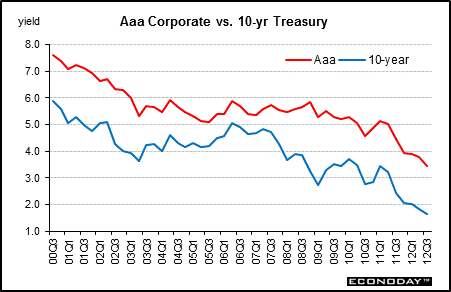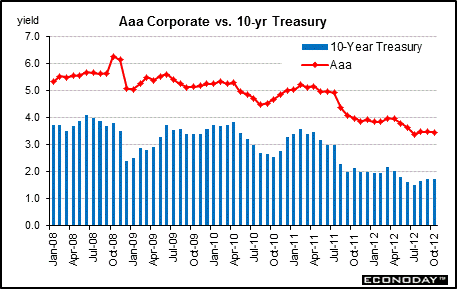 |

In 2000, the U.S. Treasury announced that it would borrow less and therefore issue fewer securities. This lifted prices of Treasury securities and reduced their yield. However, this move by the Treasury did not mean that corporate bond yields would be lower as the two markets are somewhat independent. So the gap between corporate bond and Treasury yields widened. In 2001 and 2002, the gap widened further – this time caused by deteriorating credit conditions in a softening economy. The gap narrowed slightly from 2003 to 2006 but widened in 2007 and into early 2009 over subprime problems and their impact spreading to other sectors. The gap narrowed during the second half of 2009 and into early 2010 as the economy began recovery and flight to safety reversed somewhat. When the Fed announced a second round of quantitative easing in mid-2010, Treasury rates were under a little more downward pressure. So-called QE2 ended in the second quarter of 2011 but the economy turned sluggish in 2011 and into 2012 while worries over European sovereign debt weighed on Treasury rates due to flight to safety. The Fed’s “Operation Twist” was implemented in September 2011 extended through 2012 and QE3 started in September 2012. Both weighed on long rates.
The corporate bond rates are from Moody’s. This company has a slightly different nomenclature for its ratings, compared to Citigroup’s ratings. Moody’s broad categories begin with a capital letter (A, B, or C with A being the highest quality and lowest credit risk). Each broad category is differentiated into further subdivisions with a lower case “aa,” “a,” or no additional letter. The following are in descending order of quality – Aaa, Aa, and A. Citigroup’s ranking system uses all capital letters. According to Moody’s, obligations rated Aaa are judged to be of the highest quality, with minimal credit risk.

The 10-year Treasury note yield had been on a downtrend in late 2008 on flight to quality but reversed course in early 2009 on economic data showing an easing in the recession, the start of recovery, and due to projections of ballooning federal deficits. Corporate bond rates remained elevated in early 2010 eased on signs of slippage in recovery, increased concern about European sovereign debt, and on the start of QE2. Recently, rates have been under pressure from flight to safety and the Fed’s policy statement of continued low rates, now expected out through mid-2015 and on QE3. The yield on 10-year Treasuries rose 3 basis points in October to 1.75 percent while the average yield on Aaa corporate bonds edged down 2 basis points to 3.47 percent.



Production & Sales •
Inflation •
Federal Reserve Policy •
Interest Rates
|
 |